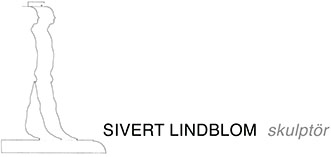Sivert Lindblom
We are faced, quite simply, with a turned and painted ”knob”. Then suddenly we discover that the profile of the knob is that of a face. As we realize this, it feels as if a head had suddenly turned inside the sculpture – like a sort of futuristic shiver …
These sculptures thus have a figurative content. We have a sort of reversed painting – since if a painting is a flat surface portraying curved surfaces in imaginary space, we see here a curved surface portraying a flat profile or projection.
When our imagination made a cut in his earlier sculptures, it met matter, a mass of given consistency. It now encounters instead the projection of a face, a form. Only in a few cases has Sivert Lindblom made such a cut in ”reality”, in the actual sculpture. In the majority of cases, the spectator himself must ”in spirit” saw in two the sculpture to find the picture, the silhouette. It is customarily said that sculpture is a more ”realistic” art than painting, since it retains the third dimension of reality — which is dispensed with in painting. To me this has always seemed a dubious proposition — it may, perhaps, have been valid for Mme Tussaud, who was in fact concerned with the unreal, with illusion. In Sivert Lindblom’s case, it is utter nonsense to speak of the ”realistic” status of sculpture.
In his sculptures, it is not only the third dimension of the object portrayed that becomes imaginary. The two other dimensions – those of the plane — are also imaginary.
In his most interesting and complete works, the profile is completely overshadowed by the curved surface that the sculpture comprises.
The actually visible form and the interpreted ”cerebral” form are as unlike each other as they could be.
If I understand his work aright, it is precisely this disparity that he wishes to achieve. The profile — the self-portrait — is in itself of no great interest; he could just as well have taken the profile of Caesar, or a bottle, or a Chevrolet. It is of the gap between the seen and the comprehended, between sensual impression and conception, that this entire exhibition treats – he has filled the premises with a mysterious mental vacuum: that from which our every thought flashes.
Ulf Linde
